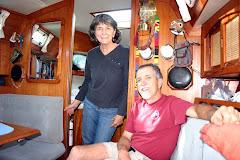We arrived a day early, and decided to visit the neighboring island of Vaka'eitu. The resort mentioned in our guidebooks was nowhere to be seen, and we later learned that it had closed several years ago after the owner's death. There were several small kids playing on the beach, so we dinghied ashore to see if they could tell us where to find the trail to the other side of the island. Soon we were off tramping through the jungle, led by Kaho, Kava, Ana, and Rosaline. Their mother told us that she has 11 kids altogether, ranging in age from 1 to 20.

The next day we moved over to Lape Island, and decided to visit the village before the feast. As in other villages we have visited, Lape has solar panels and storage batteries for each house, courtesy of Japan.

Lape also has a nice schoolhouse and a well-trained teacher, even though there are only eight students in grades 1-6 (secondary students must got to Neiafu).

In one home several people were at work preparing for the feast, making leis and other craft items.

As time approached for the feast, dinghies began to arrive at the wharf. I didn't get a precise count, but there were at least 34 people from 13 different yachts, mostly from Australia, New Zealand, and North America.

Vicki bought several woven items from the craft booth.

Tola, one of the village elders, holds Miles, one of the youngest cruisers at this week's feast.

In front of the schoolhouse, Kolio showed us how items were made from local materials. Some of the woven items last a very long time, and are even passed down from generation to generation.

The next day, we went snorkeling on a nearby reef, with some of the healthiest and most diverse corals we have ever seen.



No comments:
Post a Comment